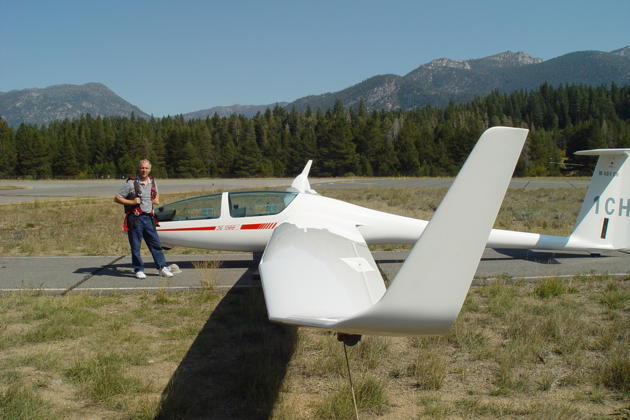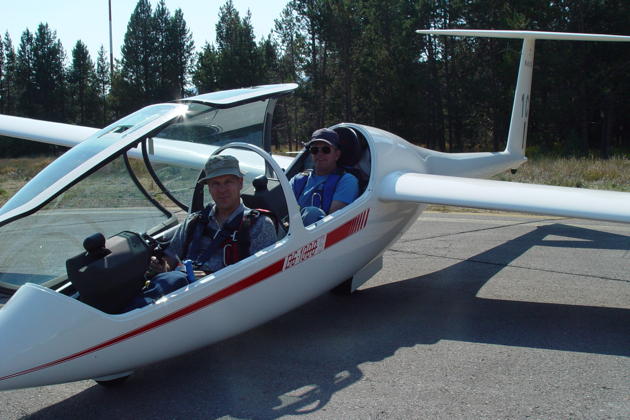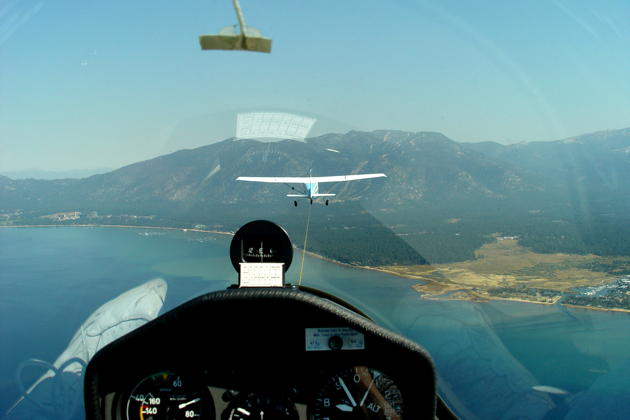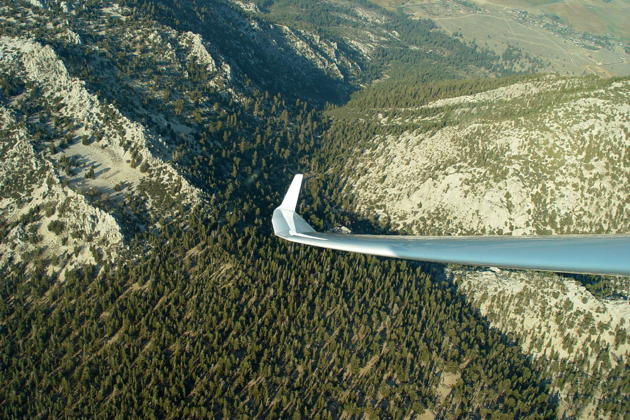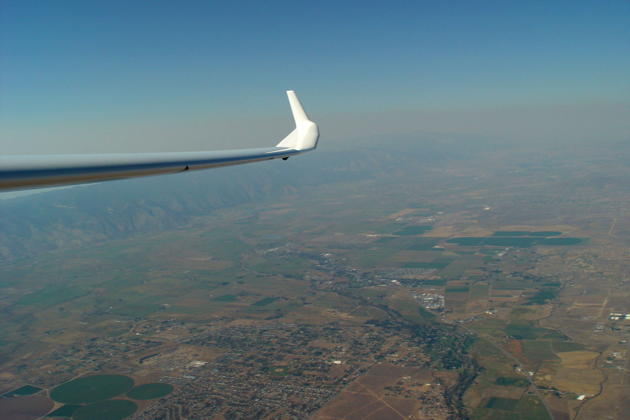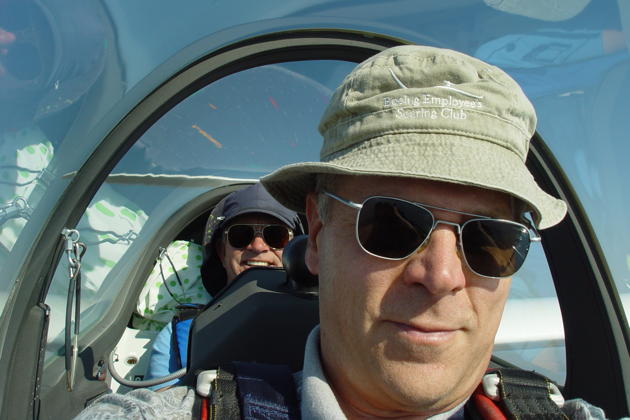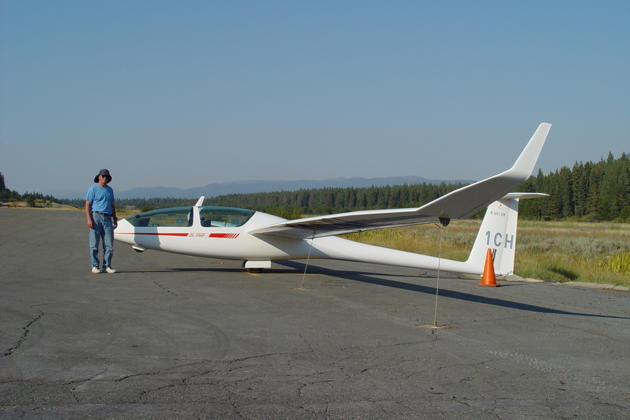FlightLog Archive
∟Aircraft Flown
Checking Out in the DG-1000 - Sep 2003
As the time for arrival in the Northwest of Lynn Weller's brand new DG-1000 came closer, I tried to look for an opportunity to fly a DG-1000 to help get myself acquainted. I wanted to get a good understanding of the DG-1000 and its flight characteristics, in order to provide a good transition plan and orientation for Lynn as he checked out in his beautiful new sailplane. Since the DG-1000 is so new, there are only a few of them in the states. I found out that Charlie Hayes owned one, and he offered flights out of Lake Tahoe airport, at the south end of Lake Tahoe. Since I was heading to California on business, I arranged for a detour to Reno, and drove out to South Lake Tahoe for an orientation flight in this impressive sailplane.
Charlie Hayes was quite proud of his DG-1000, and rightfully so - it's a beautifully built machine. Charlie and I walked through a detailed pre-flight, and I got familiarized with the exterior of the sailplane and then the cockpit setup. One unique feature on the DG-1000 is the solid ballast system, which consists of brass weights, totaling up to 26.5 lb, that are placed in a compartment in the vertical fin that is covered with a piece of clear plastic for viewing. In addition, a cockpit indicator light flashes after weights have been added, indicating the amount of ballast loaded. A good pre-flight will need to understand the intended pilot's weights, and the necessary ballast required.
The DG-1000 cockpit is laid out conventionally, with good shoulder and sitting height room in the front cockpit, and even more in back! The rear cockpit height adjustment is provided by an adjustable seat pan. Latching of the individual canopies is conventional, but some care must be taken in the front cockpit as the canopy frame often touched the spoiler handle as the canopy was being lowered. Rudder pedals are adjustable in front, but not in the rear cockpit.
The DG-1000 can be flown in an 18-meter configuration, but today Charlie had the ship outfitted with the upturned 20-meter tips, which still allowed for basic aerobatics and spins. The aerotow hook is fitted at the very front of the nose. We setup on the taxiway next to Lake Tahoe's runway 36, field elevation of 6264', and began a wing-low takeoff behind Lee Edling in the Cessna 182 towplane. The small wingtip wheels, just before the wingtip joint, were only needed for a short time as we turned onto the runway and quickly gained aileron control authority. We were careful to avoid the taxi lights with our 20-meter wingspan as we turned onto the main runway, and were soon airborne behind the tow.
Pitch authority and control were quite normal, and Charlie's suggestion to use a takeoff trim position just slightly aft of the takeoff trim line proved effective. From recent descriptions in Soaring magazine and discussion of the new JAR rules for roll feel, I expected the aileron forces to be heavier than they actually were. Instead, the DG had a feeling of stability on tow, seemed to take bumps and upset attempts in stride, while still having enough authority to handle requested inputs. Visibility was outstanding! We climbed over the south end of Lake Tahoe, then towed up into the Sierras to the southeast, hoping to find some thermal activity. Raising the gear on tow felt slightly heavy, but the leverage on the gear handle was quite good. A nice feature was an eyeball vent louver on the right side of the cockpit that provided nice ventilation.
Although Charlie said the previous week's soaring conditions were poor, I was able to connect with a nice thermal shortly after release from tow, and was able to crank the DG-1000 around very nicely and quite quickly climb to 14, 300' in the local Sierras. I initially tended to thermal a bit too fast, then settled into a decent groove after resetting the trim to help out. The DG-1000 was very stable in 45 degree thermaling turns, and even seemed to thermal a bit better after using Charlie's suggestion of a bit of top rudder in the turn.
With decent altitude under our belt, it was time to check out the cross-country capabilities of this 47:1 glide ratio bird. We headed nearly due east from the Sierras across the Carson Valley south of Minden, Nevada to the Pine Nut Mountains. Using the indicated MacCready speeds, we smoothly dolphined across the valley, and I felt like I was back in a jet again. This bird can cruise! Hoping to find some thermals similar to the ones in the Sierras, we headed in nearly a straight line to Mt. Siegel, then headed north along the Pine Nut ridgeline to Mt. Como without finding much lift. We cruised back south to Mt. Siegel, then finally caught another decent thermal around 10,000', climbing back to 13,600'. It felt great to point west and smoothly cruise back at a 45+:1 glide ratio across the Carson Valley to the Sierras, hardly losing any altitude in the smooth glide back.
Cruising back across the Carson Valley, we headed back over the Sierras into the South Lake Tahoe area. I flew a number of straight ahead and turning stalls, which were quite gentle, with little tendency to drop a wing. Top rudder was quite useful in recovering from turning stalls. Charlie then flew one spin, and I flew a second, using the flight manual technique of full opposite rudder against direction of spin, pausing, then easing stick forward until rotation ceases, and then carefully pulling out of dive. For inexperienced pilots, the only concern might be the DG's tendency to pick up speed quickly when nose low, so recovery from spins should stress good pitch control in the recovery. We were able to recover with speed increasing only to 79 knots.
As we descended into the Lake Tahoe pattern, I tested out the double-segmented top-surface airbrakes, which are very effective. A nice standard feature is the Piggot hook, which helps avoid inadvertent release of the airbrakes on takeoff. By rotating the handle slightly inboard, the Piggot hook is bypassed for normal airbrake operation. I used 60 knots for a slightly fast approach to Lake Tahoe's runway 36, and was pleasantly surprised by how easy it was to maintain my chosen pattern speed. Touchdown and rollout were quite pleasant, and we rolled to an accurate stop using the very effective brake, operated using the airbrake lever. Charlie's DG-1000 has an added small nose wheel, but Lynn's configuration only has the large main, so care will be needed to avoid pitching over when using too much braking.
In all, the DG-1000 is a fantastic two-place ship with great cross-country and aerobatic training capability, and I can't wait to fly one again here in the great Northwest!
Thanks, Charlie!
 KASPRZYK
KASPRZYK